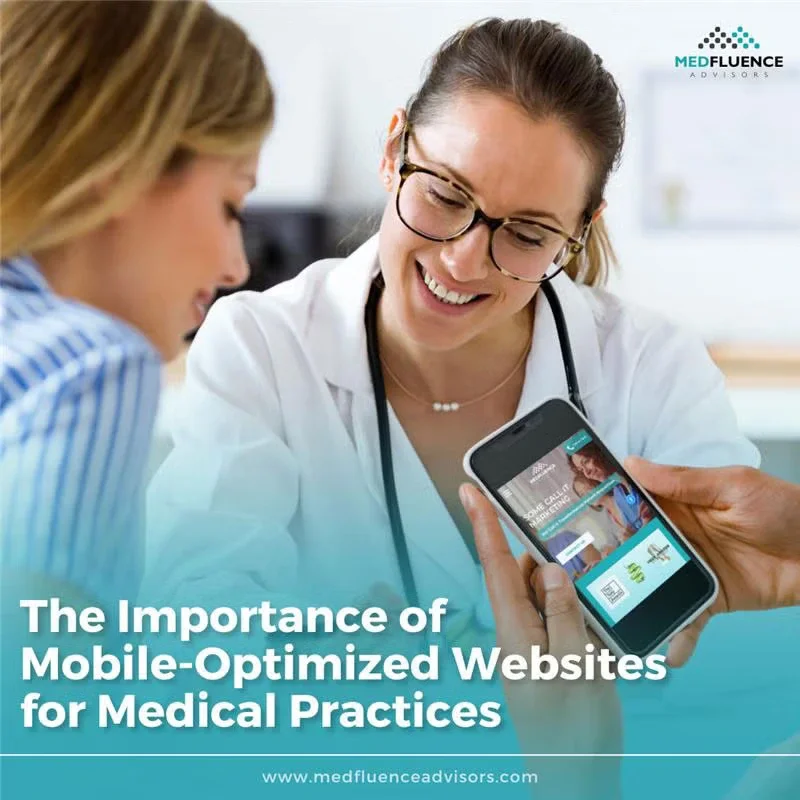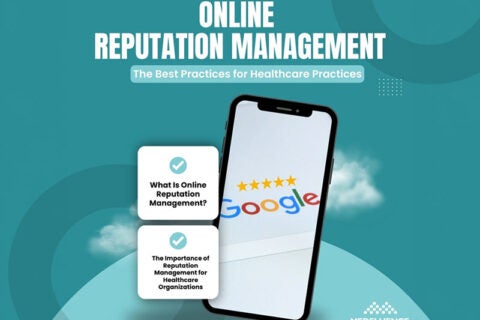The Importance of Mobile-Optimized Websites for Medical Practices

In today’s digital age, people increasingly rely on the internet—search engines, social media, and online reviews—to research healthcare providers and medical facilities. The information they find plays a key role in shaping their health decisions.
Changing patient expectations doesn’t only mean that patients expect better results and more effective treatment plans from their medical providers. It also means patients want convenience more than ever – especially at a time when they are already dealing with complicated medical issues.
By now, most businesses, including those in the medical sector, understand the critical importance of having a mobile-friendly website. It’s no longer a luxury or optional—it’s an absolute necessity, and for good reason.
The Use of Mobile Devices in the Digital Age
The use of the internet via mobile devices has skyrocketed in recent years.
As of October 2024, 60.4% of global web traffic came from mobile devices. In the United States alone, 47.64% of all web traffic comes from mobile devices. It was only back in 2012 that 10.74% of web traffic was from mobile devices.
This rising trend of internet usage using mobile devices is especially relevant in the healthcare sector where patients increasingly rely on their handy smartphones to look up healthcare facilities, communicate with their healthcare providers, and book appointments.
Because of this, having a mobile-friendly website for your practice is more crucial than ever. It’s more than just an upper hand to give your practice’s website a seamless appearance. Rather, it’s providing your patients the convenience they want and need so they choose to do business with your practice, allowing you to stay relevant in a saturated marketplace.
What Is a Mobile-Friendly Website?
A mobile-friendly website is a web design approach that optimizes your business website so that it is fully functional, easy to navigate, and visually appealing on mobile devices, smartphones, and tablets.
A mobile-friendly website is one that can adapt and adjust its layout depending on varying screen sizes on different devices. It means that the website remains readable and with clickable links and properly-sized elements regardless of where the visitor accesses the site.
A mobile-friendly website is essential for medical businesses today. It helps you reach a broader audience, especially those who rely on mobile devices, and ensures your organization delivers an exceptional patient experience.
The Benefits of a Mobile-Optimized Website for Your Practice

Having a mobile-friendly website brings about a variety of benefits for many medical businesses. Your private practice business can enjoy such advantages:
1. Improved patient experience
Healthcare organizations and facilities must do everything in their power to provide their patients with the best experiences not only in-person but also online.
A mobile-friendly website will ensure that all patients and website visitors can easily access and navigate your website through handy smartphones or tablets. They should seamlessly gain access to any information they are seeking.
Visitors to your website are likely to be dealing with complicated medical stuff and issues and the last thing they want is to deal with complicated websites that are not user-friendly. They want to access what they need without the hassle and a mobile-friendly website should help with that.
When visitors and potential leads have a positive experience with your website, they are more likely to trust your practice and do business with you.
2. Increased website accessibility
Today’s modern patients are always on the go. People are busy and always moving. They access almost everything through their smartphones or handy tablets, foregoing accessing websites through laptops or computers altogether.
Having a website for your medical practice is the first step to making your business accessible. Take this further by ensuring your website is mobile-optimized and friendly on all devices from where patients access it. This makes it easier for visitors and patients to access important healthcare information and medical services from the convenience of their mobile devices.
3. Increased patient acquisition, engagement, and retention
A mobile-optimized website is one step closer to ensuring a positive patient experience. When potential leads have a positive experience with your website, it can lead to higher conversions, leading to more sales which is good for your business in the long run.
Additionally, mobile-friendly websites encourage higher patient engagement. When websites are smooth and fast regardless of where they’re accessing them, patients and visitors are likely to enjoy enhanced patient engagement and communication. This includes interacting with the elements in your website, accessing chat support, or scheduling appointments and consultations.
Consistent positive patient experiences build trust and loyalty. When patients have a seamless journey with your practice, they are more likely to return when needed. High patient retention is key to staying relevant in the competitive healthcare industry.
4. Improved SEO rankings
Search engines, like Google, prioritize mobile-optimized websites in their search ranking results. Google uses the mobile version of a website’s content for indexing and determining its ranking in search engine result pages (SERPs). This is called mobile-first indexing .
Google is the most used search engine in the world, so obviously, businesses will want to rank high on its result pages. Factors like mobile-optimized web design, loading speed, and ease of navigation all play a role in how Google ranks your website among your competitors.
A higher SEO (search engine optimization) ranking will increase brand visibility. This helps them get found by their target audience, increasing website traffic, patient retention, and generating more sales.
5. Competitive advantage
The healthcare industry is a highly saturated and competitive landscape. There is a lot of competition. There are other private practices in your community but also larger healthcare entities that many patients are choosing over smaller practices.
Having a mobile-optimized website will give your practice a competitive advantage over other medical practices in your vicinity. Patients are more likely to choose a medical practice with a seamless and optimized website when they access it from one of their mobile devices. It directly translates to a positive patient experience which is a huge determining factor in many healthcare decisions.
A mobile-friendly website will help your practice stand out from the noise.
6. Cost-effectiveness
Optimizing your existing website for mobile devices eliminates the need for a separate mobile site, reducing maintenance costs and increasing efficiency.
This is good news for smaller private practices that don’t have access to bigger marketing budgets as larger healthcare entities. It helps them reduce costs but still increases patient acquisition rates and fosters business growth.
Key Features and Elements of a Mobile-Friendly Healthcare Practice Website
There are specific essentials to create a truly mobile-friendly website for your medical practice. If you’re in the process of optimizing your business website for smartphones, tablets, and other mobile devices, you need to consider these key features and elements:
1. Responsive and adaptive web design
A mobile-friendly website should have an adaptive and responsive design. This means the website should automatically adjust to fit any screen, whether someone is accessing it from a computer, laptop, tablet, or smartphone.
The website should provide a seamless and optimal experience regardless of the screen size. This allows users to have a consistent experience across various devices. When visitors see that your website is consistent and responsive across devices, they are likelier to deem it and your practice credible and worthy of trust.
Additionally, touchscreen compatibility is another crucial aspect of mobile-friendly websites. We are currently in the touchscreen age and patients will expect medical websites to ride with the tides.
Optimized websites should allow users on touchscreen devices to easily scroll and swipe through pages, select items, and interact with all website features without any issues. A user-friendly website will likely increase conversion rates which is what your business needs.
2. Optimized text and element sizes
A mobile-friendly website should have text and element sizes that are the appropriate size wherever a visitor visits the website – whether that’s on a computer, a laptop, a tablet, or a smartphone.
Text and elements should be appropriately sized for various devices and screen sizes. This eliminates the need to zoom in on certain hard-to-read text and hard-to-decipher elements. Ensuring this while designing your medical practice website will help create a seamless overall experience for all your visitors and potential patients.
This also enhances your website’s overall appeal. When a website looks appealing and easy on the eyes, more people will see your website as professional and trust your practice over other competitors in the market.
3. Quick load times
In today’s fast-paced world, people expect quick solutions. If your website is slow or unresponsive, they’ll quickly lose interest and turn to your competitors.
A mobile-optimized website must have quick load times so you don’t make your audience wait. Waiting can be annoying and you don’t want that to be people’s first impression of your medical practice. This can negatively impact your brand reputation.
Additionally, slow-loading websites will also bring in negative effects in terms of your search engine rankings and will greatly reduce website foot traffic.
Optimize the images on your website, reduce server response times, and leverage browser caching to help your website achieve quick load times.
4. User-friendly navigation system
Medical websites must have a well-organized and user-friendly site structure. Navigation menus must be easy to navigate, allowing all users – regardless of age – to easily access the information they’re seeking without much complications. When users can easily navigate your website to get the information they need, it enhances their overall user and patient experience. This builds trust and credibility, increasing the chances of them choosing your practice over your competitors.
5. Important information first
Mobile devices have smaller screens than computers, laptops, and tablets. This means there is a need to keep all high-value and important information above the page so they’re easily seen and accessed without having to scroll and go further down the page.
Most visitors won’t sift through entire pages of your website. To capture their attention, place important and relevant information at the top, so they see it within the first few seconds.
The kind of relevant information you will want most people to see first includes the services your practice offers, your location, and contact information. There should also be a button at the top of your page that will allow patients to schedule appointments with your physicians.
6. SEO optimization
To be able to rank high in SERPs, your practice’s website must follow SEO best practices. This includes:
- Using relevant SEO keywords in your website’s titles, pages, and content
- Leverage and optimize page titles and meta descriptions
- Optimize the images on your website
- Publish relevant and high-quality content regularly
- Build backlinks to your website
- Optimize the website’s loading speed
7. Quality content
Relevant and high-quality content is a must for professional medical business websites. Ensure that the content you regularly publish is informative, relevant, and well-written. This keeps your audience engaged and interested. Additionally, publishing informative content backed by facts and science will build your credibility in the healthcare industry. This makes people trust your practice and your expertise more.
8. HIPAA-compliant and patient-friendly forms
The healthcare industry is plagued with rules and regulations healthcare practices must abide by. Make sure that collected patient data and information on your website are HIPAA-compliant. They should be secure to protect sensitive and personal health information and make sure your visitors know that their information is safe and secure with your website. The assurance will go a long way and allow more people to trust your website and your practice soon after.

Conclusion: Why Your Practice Needs a Mobile-Optimized Website
The healthcare industry is constantly changing and evolving. Mobile-optimized websites are no longer just a convenience or an option – it is now a necessity.
Today’s modern patients are always busy and moving. They want convenience where they can get it – especially in things concerning their health. They have changing expectations of the healthcare they receive and they expect healthcare businesses to keep up.
Ensuring your medical practice website is optimized for mobile devices gives your patients and website visitors a seamless experience regardless of what device they’re using. This builds credibility and lets them know that they can trust your practice. This, in turn, results in the rise of patient acquisition and retention rates, fostering business growth.
Lastly, ensuring that your medical website is optimized for mobile devices gives your practice the competitive advantage it needs in a saturated and crowded marketplace.
Take the time to design your website so that it’s optimized and well-structured across various devices and screen sizes. You don’t want your practice to be left behind in this constantly evolving landscape.


